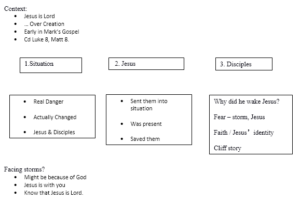I recently saw a question on The-Social-Media-Platform-Formerly-Known-As-Twitter asking about how people prepare for preaching a sermon. I wrote a short Twitter-esque reply, but thought it was worth a fuller treatment, in case either anyone is interested, or that it may even be helpful!
TL;DR
- Know the context
- Marinade in the scripture
- Draw up a draft
- Practice and refine
- Pray and seek God at every stage!
And read these books:
- “Misreading Scripture with Western Eyes” by Randolph Richards and Brandon O’Brien (IVP 2012)
- “Short Stories by Jesus: The Enigmatic Parables of a Controversial Rabbi” by Amy-Jill Levine (HarperCollins 2015)
- “Talk Like TED: The 9 Public Speaking Secrets of the World’s Top Minds” by Carmine Gallo (Macmillan 2014)
Know the context
My first step, as with any talk or presentation, is to establish the context. What sort of service is it? Who will be present? How long should the sermon be? Is there a particular theme? Is the Spirit been on the move in a certain aspect of the church? Is there a “party line” from the church leadership? At what point in the service is the sermon?
Some of these are potentially contentious or controversial, depending on your theology. For example I have a certain ambivalence to thematic preaching, as it’s very easy to squash in a token bible reading to fit what you want to talk about. I also think it assumes a pattern of church attendance (i.e. every week) which doesn’t always match up to the reality.
However I am also a firm believer in operating under authority, especially as an Associate Minister, and I will always seek to publicly back up the vicar/PCC. Of course, this is not blind or unqualified support – particularly thinking about the church’s history on abuse, most recently in the case of Soul Survivor and Mike Pilavachi. It also doesn’t mean being a “yes man”, and in private I will challenge and debate where I think we may be missing the mark. Anyway, I digress.
As some concrete examples, think of how sermon preparation would be different for these contexts:
- A “normal” Sunday Holy Communion of 5 regular, committed, church members.
- A “normal” Sunday Holy Communion of 150 regular, committed, church members.
- A seeker service
- An early morning service, with a 5 minute homily
- An evening service, with an hour’s exposition on a bible passage
- A funeral
- A family service, with ages from 0 to 100+ present
- A youth or student worship service
- A sermon during an act of worship at a theological college
- A prison
- A school
- … and so on
Reflection on the context should help to answer questions around:
- The length of the sermon
- The language to use
- The depth of the content / theological assumptions
- What level of interactivity
- What props to use
- Whether to use a PowerPoint type presentation
- What form an application or response might take
- What sort of humour/stories may be appropriate
- What sort of humour/stories wouldn’t be appropriate
Marinade in the scripture
I try to start to think about the sermon at least two weeks before I’m preaching. I like to read the passage (or identify the theme) and mull it over. I try to come to it with fresh eyes – is there anything I’m skipping over. What are my cultural filters?
At this point I have to recommend a couple of books; “Misreading Scripture with Western Eyes” by Randolph Richards and Brandon O’Brien (IVP 2012), and “Short Stories by Jesus: The Enigmatic Parables of a Controversial Rabbi” by Amy-Jill Levine (HarperCollins 205). The second in particular isn’t very comfortable reading, but both certainly opened my eyes to some of the assumptions I (and our churches) make when reading scripture.
I sometimes do a lectio divino on the passage, to see what the Spirit might want to draw my attention to. Even if I’m not, I try to settle myself, ensure I have some quiet time and space, and just sit with the passage for a while, reading it over and praying through it.
I will sometimes dig out a commentary at this point, and will also reflect on resonances with other parts of the Bible. I will start to muse over whether there’s anything I’ve read which speaks to this passage. I will think about what quotes there might be. Or personal stories from my own life. I also start to keep my ears open for anything I come across which speaks to this passage. The internet has been a God-send for this, as I will often think “H’mm – I read something in Church Times about that”, and I can go and search it up.
As a slight aside, I keep a sermon scrapbook, and whenever I come across something which speaks to me in a newspaper or magazine, I cut it out and stick in the scrapbook. A lot of it I will may never use. My only tip is to make sure that you’ve either included the reference in the cutting, or write it alongside in the scrapbook.
Draw up a draft
This is probably what most people think of as writing a sermon. Turning the thoughts and musings into something ready to speak.
I usually start off with a mind-map, and get my thoughts and musings down on paper. I almost never keep them, so I can’t given an example, but a quick google gives lots of hits: how-mind-mapping-has-rejuvenated-my-sermon-preparation.
At this point I am just downloading ideas and following trains of thought, so see what emerges. I might identify areas I need to do a bit of research, have a look at different translations, read a commentary, maybe even dig into the Greek or Hebrew if I get very excited. Try and identify parallel passages.
The next step for me is to start to shape it, and how I do that depends greatly on the context. If it’s a ‘normal’ Sunday service I usually identify 3 major themes or points, each of which has 3 sub-points. I don’t necessary explicitly identify these when preaching, but I can hold 3×3 elements in my head, so can preach it with minimal notes. I quite like the following quote – I don’t know who said, and it’s far from the whole story, but it’s an interesting thought.
If you can’t keep your sermon in your head, how do you expect other people to?
So this ends up the following structure:
Introduction A B C A1 B1 C1 A2 B2 C2 A3 B3 C3 Conclusion
This approach/structure comes from one of my favourite books on public speaking, “Talk Like TED: The 9 Public Speaking Secrets of the World’s Top Minds” by Carmine Gallo (Macmillan 2014). Once you get to longer than 10 or 15 minutes this technique runs out of steam a bit.
My notes when I’m using this technique look like this (for a sermon entitled “Jesus is Lord: Over creation – Mark 4:35-41”)
Another approach I’ve been experimenting with recently is sketchnoting, which is sort of like inverse note taking. This is much more of a journey, and is (obviously) far more visual than either a full script or the TED-like approach.
This ends up looking something like this:

Finally, if I get completely stuck, or is it a service where the language or timing is critical, I do write out the entire script verbatim.
So this is the opening of my sermon for our 2018 Remembrance Day service.
Pour out jug of sand
Never Again.
These were the words spoken one hundred years ago today, as the Armistice was declared, marking the end of the first World War. Of course at the time it wasn’t the first world war – it was The Great War – The War To End All Wars. And Never Again would future generations have to face the horror and pity of war.
Never Again.
And yet, just twenty years later, the world was at war again. Even today, UK armed forces are deployed around the world, and involved in ongoing wars in Iraq and Afghanistan.
Never Again?
In the great war, over 900,000 British soldiers died. Nine Hundred Thousand. That’s about the same number of grains of sand that I poured out when I first came up. Each individual grain of sand representing a British solider who died.
But of course, that’s only British soldiers. 10 million soldiers died in all.
Pour out rest of sand
…
Practice and refine
By this point I have the essence of the sermon.
What I do now is practice it – I mean literally shut myself in a room and deliver it. Make sure the timing is right. Make sure I know how I’m starting and ending it. Work out exactly how I’m going to tell that story, or assess if that joke is going to work. See if there’s bits which need to be cut or expanded upon. Try and form it into a cohesive whole.
Of course, if you are using a script, this is the editing phase of the script. But if I’m not using a script I rehearse it in my mind often right up to when I actually stand up to preach. Choice of phrase. Pause points. Which bits to repeat for emphasis.
For me, this is very much about the delivery.
In general terms, the longer the sermon the less “tight” it has to be. So if it’s an hour exposition, I will probably not rehearse it the whole way through, but will make sure I know what I’m saying for every verse, and then play it by ear on the day. For a ten minute sermon, I reckon you need to know the exact message and phrasing if you’ve any chance of keeping to time.
Incidentally don’t shy away from ruthless editing. My spiritual director once told me that he writes his sermon on Monday, sets it aside for the week, and then picks it up again on Friday and deletes half the words!
Pray and seek God at every stage!
This should go without saying – but ultimately preaching is huge privilege, and we’re seeking to share God’s heart with the congregation. That is an awesome responsibility, and not to be taken lightly. Throughout my entire sermon prep my dual prayer is “God help me”, and “may these words be your words”.
I hope that it is never my message when I preach, but God’s message through my words. Bishop Helen-Ann Hartley (now Bishop of Newcastle) once prayed this at the start the start of one of her sermons, and it has really stuck me with. It’s from memory, so is almost certainly a paraphrase.
May the written word and my spoken word bring us to you the living Word, Amen.


